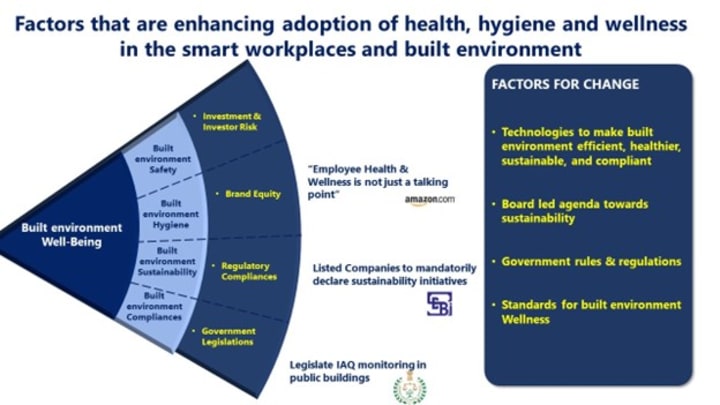A Changing paradigm: Hygiene, Health, and Wellness as critical priorities for smart built environment and workplaces
Growing sustainability, ESG and compliance frameworks and awareness on Health and well-being spurring demand for smart built environment

The pandemic threw up many new challenges in our lives and especially in the built environment and the workplaces sector.
As return to work started happening, new work formats evolved, and therefore, remote working, work from home, and hybrid working gained significant adoption.
While ‘work from home’ and remote working would apply to a type of work and, in most cases, a small section of the organization, hybrid working is emerging as the most preferred work format post-pandemic worldwide.
Technology is acting as a catalyst to transform legacy; as a built environment, the emergence of smart and connected workplaces is gaining attention and a higher adoption rate.
However, the smart workplace and built environment paradigm are now undergoing significant reorientation. Hygiene, Health, and wellness are becoming critical business imperatives from ESG, compliance, and sustainability objectives from an organizational strategy standpoint.
The genesis and the evolution of smart built environments and workplaces
Researchers and technology pundits are forecasting that human-controlled functions will progressively reduce in the coming 10 years and give way to autonomous and platform-enabled services in most spheres of B2B services.
As the digital ecosystem gets a further impact on human life and society, the proliferation of digital applications and technology in the built environment workspaces is now an established phenomenon.
According to an article published by Deloitte “The digital built environment and workplace is more measurable and manageable”. Transforming the digital infrastructure in a built environment can help in gaining real-time insights on productivity, availability and user experience. Smart infrastructures can therefore identify patterns, nudge positive employee behaviors, and fine-tune service and support performance in the built environment and workplace.
Further, the global pandemic has significantly accelerated innovation and technology adoption in the built environment sector – at the back of new work formats like a hybrid, remote, and WFH and new engagements, namely Gig, which is accelerating the physical workplace design and layouts.
Technology facilitates the built environment and workplaces to remain agile, experiential, productive, and collaborative.
The smart workplace is a new technology-enabled product form that allows the work environment to meet current and future business needs while creating a digital experience framework that fosters efficiency, collaboration, and high levels of engagement.
Smart workplaces in built environments are, therefore, the empowering and transformation lever that helps businesses operate in the new built environment while remaining contemporary, compliant, and efficient.
The smart workplaces in the built environment have seen significant adoption search – as last mile connectivity of the internet, mobile computing, and digital-first mindset is rapidly increasing in the world, especially with Gen Z and younger workforces.
Hygiene, Health, and wellness as a key priority in the smart-built environment and workplaces
In the post-pandemic world, built environments and workplaces are being repurposed with three key objectives :
1. Shield of safety – Hygiene, Health, and wellness
2. Agile
3. Collaborative and experiential environment
In response to this, organizations have started to focus on hygiene, health, and wellness programs to meet global standards like WELL, V2, RESET, and LEAD, GBC to name a few. These standards are prescribing guidelines that would make the built environment and the workplaces not only smart but a complaint to current and evolving standards, which converse with the larger goals of sustainability and ESG, which most organizations are now committed to comply with.
In certain countries like in UAE, the government is already legislating standards like Indoor air quality and other related guidelines that helps in meeting the Health, hygiene, and wellness agenda in the built environment and workplaces. Interestingly similar initiatives are being taken by the government of India to prescribe and legislate Health, hygiene, and wellness guidelines for commercial buildings, offices, and factories.
While “smart” Built environments and workplaces promote a digital-led service, people, process, and outcome management that elevates occupant experience and performance. The new paradigm in a “smart” built environment is also getting extended to provide a hygienic, Health, and wellness complaint environment in this new world of workplaces.
The diagram below demonstrates how key drivers like sustainability, Health, Engagement, and Productivity get improved in a smart workplace which also addresses hygiene and wellness as a key matrix and performance objective.


Growing sustainability, ESG and compliance frameworks and awareness on Health and well-being spurring demand for smart built environment.
Global and regional legislation, international standards and compliance, and organizational commitment to sustainable goals and ESG practices are prompting rapid adoption of Health, hygiene, and wellness-led investments in workplaces and built environments.
The illustration below (Fig. 2) demonstrates how companies like Amazon are championing workplace Health, Hygiene, and Wellness as measures to elevate their brand equity.
While market regulators like SEBI in India are insisting on and legislating guidelines so that listed companies in India ensure that they report on their ESG goals and achievements as a part of their annual reports, further regulators like NGT (National Green Building Tribunal) have passed a judgment to enforce the government of India to firm up Indoor air quality guidelines for all commercial buildings in India.
While ‘digital’ became a global enabling theme across all facets of human life, the workplace and built environment are rapidly transforming to adopt technology and transform how the future of work would be reimagined. Therefore, smart environments cannot, in the future CANNOT remain smart if the design and impact do not address the Health and well-being of their occupants.






Comments
There are no comments for this story
Be the first to respond and start the conversation.